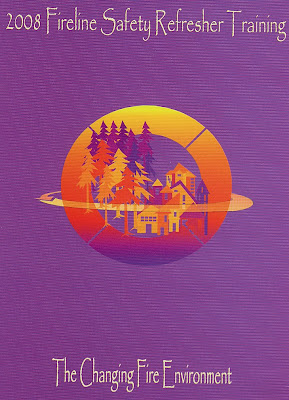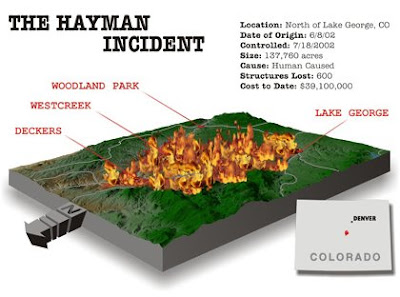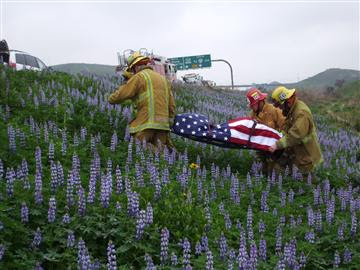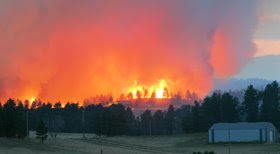
Having returned from Roatan Island, today I had a chance to review this year's
Annual Wildland Refresher Training. As usual, it is well done and of high quality. The sections about the fire behavior, the Alabaugh Fire entrapment, and treatment for burn injuries are very interesting. Several interviews contributed a great deal to the DVD, including those of Dr. Bret Butler, Kelly Close, Dr. Ted Putnam, and Tom Boatner. The DVD even includes a copy of the piece that "60 Minutes" did on "Mega Fires" last summer.
Alabaugh FireThere are quite a few issues related to the entrapment that could be opportunities for learning related to this fire which burned 10,324 acres and 27 homes. One homeowner died when he went back to try to save his belongings. The fire started from a lightning strike on July 7, 2007.
Some of the issues are mentioned only briefly in passing, perhaps to avoid criticizing the personnel who were involved. Some of the firefighters assigned to the fire were kind enough to step forward and discuss on camera their ordeal. They deserve our thanks for helping others to avoid a similar situation down the road. I hope the facilitators putting on the training this spring can allow enough time for some of these issues to be expanded upon.
Treatment for Burn InjuriesOne of the units in the video describes the horrific situation that two federal employees faced after being burned on wildland fires.... and unfortunately I am not only referring to their burn injuries. The injuries are of course terrible to have to experience, but what could have made them even worse were the delays in being able to obtain adequate medical care.
Burn injuries are very complex and can't be properly treated by a primary care physician, a trauma center, or an emergency room, even if they have access to a plastic surgeon. Burn injuries require immediate treatment by trained specialists who deal with burns every day. Every day. In many cases, burn injuries will not heal properly or the healing will take much longer if the injuries are not treated quickly by the staff at a "verified burn center". Waiting days or weeks is not acceptable. The
American Burn Association has more information about the
verification process and also has a list of
burn centers that qualify for this status.
In both cases on the video, the federal firefighters received treatment locally at emergency rooms soon after their injuries. After being discharged from the ER, they then, rightfully, tried to get proper treatment in a burn unit, but encountered administrative roadblocks in trying to deal with their agency and the
Office of Workers Compensation (OWCP).
Eventually both victims, federal firefighters, received treatment at burn centers, but in one case it was three weeks after the injury.
Some of the following information came from the refresher video, some from my research, and some is just common sense.
What a firefighter should do if they are burned- Obtain immediate treatment at an emergency room to stabilize the injuries.
- Before being discharged from the ER, if the injuries qualify under the criteria below, get a doctor to refer you immediately to a verified burn center. For federal employees, if this is done, the expenses for this further treatment by the burn center will be covered by the initial CA-16 form all the way through to recovery.
- If this is not done, you will have to then go to a primary care physician and convince them to give you a referral. This will take time.... time that you don't have.
- If you are having trouble obtaining adequate treatment and your agency will not help, contact the non-profit Wildland Firefighter Foundation at 208-336-2996. They are experienced in these issues and have access to attorneys who can help sort through the roadblocks. They can also provide money for the firefighter and their families if needed for travel or other purposes.
What employers of firefighters need to do In advance, before anyone is injured, establish these policies
- Every person with a burn injury that qualifies under the guidelines as one that should be referred to a verified burn center (see below) will be referred to a burn center before they leave the ER. The agency will facilitate this process.
- Designate a compensation coordinator who knows the agency and OWCP policies, to be the liaison and advocate for the injured firefighter. This person should be in frequent proactive contact with the injured person or their family, especially during the first 2 to 36 hours.
What every firefighter should do- If your agency does not have a written policy to ensure that burned firefighters receive proper treatment, ask that they establish one.
- Donate to the Wildland Firefighter Foundation. Their only goal as an organization is to help firefighters and their families, and they do a great job.
- Become familiar with the burn center referral criteria (below).
Burn center referral criteriaThe American Burn Association has a link to
these criteria developed by the American College of Surgeons' Committee on Trauma, to describe under what conditions a burned person should be referred to a verified burn center:
1. Partial thickness burns greater than 10% total body surface area (TBSA)
2. Burns that involve the face, hands, feet, genitalia, perineum, or major joints
3. Third-degree burns in any age group
4. Electrical burns, including lightning injury
5. Chemical burns
6. Inhalation injury
7. Burn injury in patients with preexisting medical disorders that could complicate management, prolong recovery, or affect mortality
8. Any patients with burns and concomitant trauma (such as fractures) in which the burn injury poses the greatest risk of morbidity or mortality. In such cases, if the trauma poses the greater immediate risk, the patient may be initially stabilized in a trauma center before being transferred to a burn unit. Physician judgment will be necessary in such situations and should be in concert with the regional medical control plan and triage protocols.
9. Burned children in hospitals without qualified personnel or equipment for the care of children
10. Burn injury in patients who will require special social, emotional, or long-term rehabilitative intervention.
LastlyFirefighters who are burned on the job deserve the best medical treatment available. Their employers should proactively see that this happens, both by having policies in place, and by having a compensation coordinator work very closely, immediately, with the injured firefighter all the way through to recovery. To do any less, is irresponsible.
And finally, the group that included the segment about burn injuries on the refresher training package should receive a lot of credit. This is important information for firefighters to have.
Click on the little envelope below if you want to email this post to someone else.
 A German industrial design studio, apparently with no expertise in wildland fire, has developed a concept for a robot that would be pre-positioned in the wildland. When it's sensors detect a fire from up to 1/2 mile away, it would wake up, extend it's 6 legs, walk to the fire, and put it out using tanks of water and powdered fire-extinguishing agents.
A German industrial design studio, apparently with no expertise in wildland fire, has developed a concept for a robot that would be pre-positioned in the wildland. When it's sensors detect a fire from up to 1/2 mile away, it would wake up, extend it's 6 legs, walk to the fire, and put it out using tanks of water and powdered fire-extinguishing agents.




















